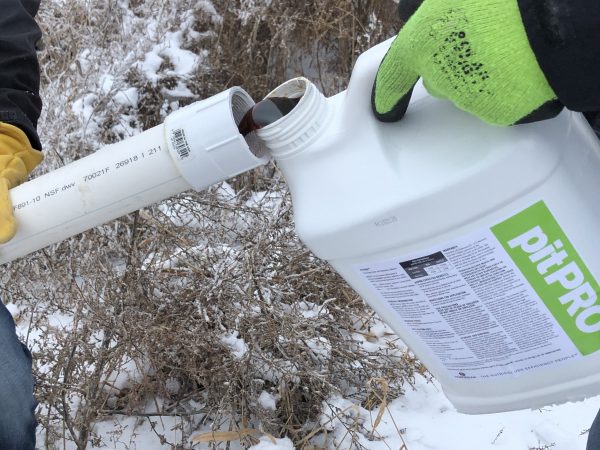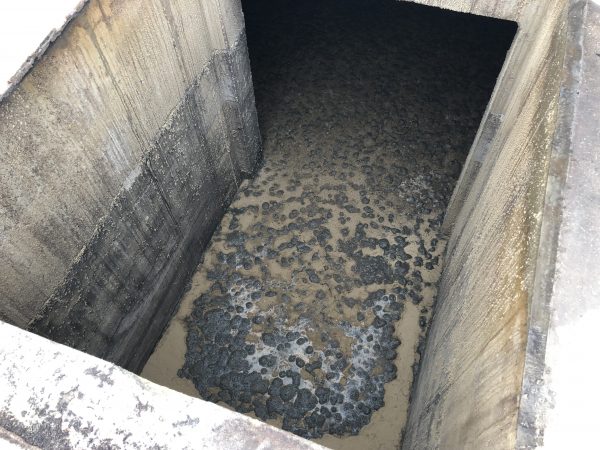
Uncategorized
Sponsored Content
Tackling management challenges
A super-charged polymer may provide solutions to a host of problems.
September 30, 2019
Sponsored by PitPro

The immediate effect can be seen in both hot and cold weather, but the greater impact on order control occurs during the summer.
Manure deserves its reputation as “black gold.” Spread onto agricultural fields, it can substantially reduce a farmer’s chemical fertilizer bill while improving soil’s structure, porousness and water-holding capacity. That said, large-scale collecting, pumping and spreading of liquid livestock manure isn’t without challenges: crusting, odor, solids build-up, flies, slow and problematic pumping, inconsistent nutrient distribution and more can make manure management frustrating, time consuming and a lot less effective than desired. Could technology change all of that?
In an ideal world, all nutrients that enter a pit would be easily and consistently pumped back out and spread evenly, in plant-available form, across crop fields. The reality on most farms is quite different.
Manure naturally separates into thicker and thinner components. The settling of solids makes pumping challenging: it’s common to fully pump a pit yet have a thick several of unpumpable solids built-up on pit walls and floor. As build-up increases, pit capacity drops: a real issue for farmers who have only just enough capacity to get from one scheduled pumping to the next.
In hog barns, build-up isn’t limited to a pit’s walls and floor: the thickness of hog manure means a several-inch deep crust – impossible to pump and the ideal habitat for fly larvae – almost always forms. Flies are more than just annoying: they can cause stress, depressed health and decreased gains in livestock.
The settling of solids also creates an uneven distribution of nutrients in the pit. Particulate phosphorus attaches to solids rather than liquids. As such, the top, liquid layers will carry significantly less phosphorus than the bottom, sludgy component. Since a pit is usually pumped from top to bottom, the natural stratification of nutrients in a pit makes for very uneven nutrient distribution in the field. While mixing or agitating the manure before pumping certainly helps, doing so can quickly cause damaging erosion of a pit’s sidewalls.
Storing manure in a pit is problematic for nutrients besides phosphorus. As manure breaks down (especially if any bacterial or enzyme-based treatment is added to the pit to speed break-down), vast quantities of nitrogen are lost as ammonia off-gasses. This off-gassing is wasteful, smelly and can compromise animal and worker health.
Various treatments exist to tackle manure management challenges. Most of the products are biological: naturally occurring bacteria or enzymes designed to help the manure break down. More recently, a variety of chemical additives have hit the market.
Among the newer products available is Pit Pro, a water-soluble, biodegradable, entirely non-toxic chemical polymer. Highly negatively charged, Pit Pro functions as a magnet, pulling manure’s positively charged solids into suspension and homogenizing a pit’s contents.

The highly negative charge of PitPro, interacting with the positively charge manure particles puts the manure in suspension, creating a consistent, homogeneous consistency, reducing solids and increasing pumpability.
Does it work? A 2018 trial of the product conducted in a 1.2-million gallon pit beneath a 5,000-head hog barn showed a 50 percent reduction in solids build-up, greatly increased pumpability, and more consistent distribution of nutrients both in the pit and, ultimately, on the field.
Larry Plagman, who finishes 1,000 head of hogs on his Rainbow Hills farm in Carson, Iowa, has been trialing the product on his own operation for two years. He says the results speak for themselves. “I’ve tried a lot of products over the years and Pit Pro worked the best of any of them.
“When I pump my pit now, I get 15 more loads out. When I pump this fall, I’ll be able to wait a whole year this time instead of having to pump in the spring when I’m busy. That’s huge.”
He’s also noticed much more consistency in his corn crop.
“Before I started using Pit Pro, I’d see yellow spots in the corn by summer where the nitrogen didn’t go on evenly. This year and last year, it’s just solid green,” Plagman says.
Rick Martens, a licensed commercial applicator and owner of Martens Manurigation, has experienced the results of Pit Pro first-hand too. “Generally you can’t get hog manure to hold suspension well: when you start pumping, it’s really watery; by the end it goes onto a field black as tar. [When treated with Pit Pro], it appeared like there was more consistency to the manure. What we found was the color was darker at the beginning and everything seemed more consistent across the field.”
He also likes the enhanced pumpability produced by Pit Pro. “One customer has a heavier pit that we usually have to add water to before pumping. He used PitPro and that’s the first time in a lot of years that we didn’t need to use any water, and we got it down all the way to the inlet pipe.”
And he appreciates treated manure’s decreased odor.
“My farmers have commented that when they added PitPro and then spread the manure on the field, they can’t believe how much the odor is down. There’s economic benefit but there’s social benefit too: that’s going to keep your neighbors a lot happier,” Martens says.
Plagman agrees. “When I started using PitPro, I didn’t tell my son. He lives at the farm and one day, maybe four months after I’d started using it, he asked me what I was doing differently, because the smell was so much less.”
In addition to decreasing buildup, enhancing pumpability, improving nutrient consistency and minimizing odor, Pit Pro also offers a secondary benefit of maximizing the availability of manure’s nutrients to plants. Whereas bacteria or enzyme-based pit additives off-gas significant amounts of nitrogen, PitPro holds onto the nitrogen in plant-accessible ammonium form. It also makes manure’s phosphorus more readily plant-available: whereas 65 percent of the phosphorus in dry fertilizer attaches to the soil as soon as it is spread, Pit Pro holds the phosphorus until plants absorb it.
Martens believes nutrient maximization could be among Pit Pro’s very most important benefits. He is currently conducting a trial in a customer’s large corn field and hopes results will be obvious by this fall.
Plagman says the benefits he’s already achieved make Pit Pro an obvious choice. “Pit Pro is definitely worth it. It’s a standard of practice for me now. I think anyone using manure for fertilizer, once they catch onto it, they won’t do anything else.”